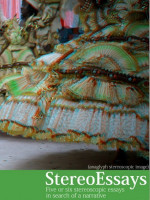StereoEssays Filming Locations

Where was StereoEssays filmed? StereoEssays was filmed in 1 locations across Brazil in the following places:
StereoEssays Filming Locations
Rio de Janeiro is a huge seaside city in Brazil, famed for its Copacabana and Ipanema beaches, 38m Christ the Redeemer statue atop Mount Corcovado and for Sugarloaf Mountain, a granite peak with cable cars to its summit. The city is also known for its sprawling favelas (shanty towns). Its raucous Carnaval festival, featuring parade floats, flamboyant costumes and samba dancers, is considered the world’s largest.
StereoEssays (2011)
The film StereoEssays / Five or six stereoscopic essays in search of a narrative is a high-tech audiovisual essay that explores ultra-definition stereoscopic images. As in the legendary Views of the Guanabara Bay (1898), considered the first Brazilian movie, made by the Segreto brothers, Rio de Janeiro is once again the focus of pioneering cameras. The difference now is that the views can be observed in three dimensions and ultra-high definition. The film is divided into five acts, plus a prologue and an epilogue. The prologue and Act I more explicitly portray the idea of views of Rio de Janeiro, with wide-angle aerial and marine shots of Sugarloaf Mountain, the Rio-Niterói bridge and the Guanabara Bay. Trucks, cranes and ships all elements in gigantic moving proportions. In 3D, the stereoscopic space is formed against the backdrop of the continuously moving machines. As stereographic filmmaker Keith Collea said about the machines: look, they work for us! In contrast, the huge, colored containers form a background chain, closed with their secrets about the objects they bring from afar. Act III explores the maze-like streets of the Tavares Bastos community and celebrates the local football players. The feet, the ball and the unpredictable movements of the boys are compositional elements of the shots which blend into the movements of the dance of Act V. The feet, hands and movements of the Mangueira dancers integrate into the movements of the ball, in an unassuming, spontaneous game, with the main objective of promoting a new visual experience. French: Stéréoessais est un essai audiovisuel qui explore des images en ultra-haute-définition et interroge le statut du 3D : nouveau langage ou simple artefact ? Comme dans Vues de la Baie de Guanabara, réalisé en 1898 et considéré comme le premier film brésilien, Rio de Janeiro se trouve à nouveau au centre des caméras, mais les vues de la ville sont désormais captées en technologie 3D et ultra-haute-définition. Les clichés brésiliens sont exposés comme dans un vivarium mis en évidence par la stéréoscopie, une technique qui révolutionne notre appréhension des images. Alors que nous ne possédions quun seul ciné-il, limage stéréoscopique permet une perception du monde visible qui nous entoure à travers un « stéréopsis ». En dautres termes, il sagit dun changement de la camera de cinéma cyclops (lil unique) vers une caméra duelle (la vue stéréoscopique). Comment pouvons-nous contempler ce nouveau monde dimages en mouvement capturées mécaniquement et électroniquement par une perspective binoculaire ? Ou plus simplement et plus directement, comment pouvons-nous approcher et comprendre un film en trois dimensions, en termes de narration ? Quest-ce que nos yeux, saturés par plus de 110 années dimages en mouvement, peuvent capter et attendre de ces images revisitées par la stéréoscopie ? Réalisé par une équipe de chercheurs menée par lhistorienne du cinéma Jane de Almeida, Stéréoessais est un film en 3D qui utilise les nouvelles possibilités visuelles afin de mettre en relation les pré-cinémas et les post-cinémas à partir des clichés brésiliens de la ville de Rio.
